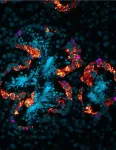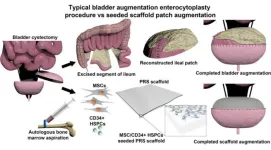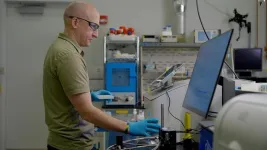(Press-News.org) More than 100,000 oil and gas wells across the western U.S. are in areas burned by wildfires in recent decades, a new study has found, and some 3 million people live next to wells that in the future could be in the path of fires worsened by climate change.
Researchers from the University of California, Berkeley, said their analysis, which was published last week in the journal One Earth, is the first to examine historical and projected wildfire threats on oil and gas facilities in the U.S. While the public health effects of scorched and damaged drill sites are unclear, researchers said the study is a necessary step toward understanding the potential compound hazards and could help inform policy about future drilling.
“Most of the oil wells in California are currently in wildfire threatened areas, and a lot of people live in those areas because of the history of oil and gas development in this state,” said David J.X. González, an assistant professor of environmental health sciences at UC Berkeley’s School of Public Health. “The same issues that have been with us historically are still with us, and it looks like they might lead to new environmental justice issues that haven’t really been explored.”
González, the paper’s first author, pointed to Los Angeles and Kern counties as populated areas plumbed for oil and gas extraction and also at high risk of burning now or in the near future. In the past, fires in oil and gas fields not related to wildfires have caused blowouts, and leaks from gas storage tanks in Los Angeles have resulted in explosions that damaged buildings. Near Bakersfield, dozens of wells have been found to be leaking natural gas, some at explosive levels.
Since 1984, almost 350,000 people across the western U.S. have lived within 1 kilometer of a well that was inside a burn zone, researchers found. Asian, Black, Hispanic and Native American people have faced disproportionately high exposure to those wells affected primarily by a handful of megafires in California, Texas and Oklahoma.
Across the West today, nearly 3 million people live within 1 kilometer of a well that is projected to be in an area with an increased risk of burning in the coming decades. What’s more, the number of wells in high-risk wildfire areas is predicted to nearly double by the end of the century.
That means more wells are being drilled in more areas expected to burn.
“I don’t want to say, ‘The sky is falling.’ But there was more of an impact than we thought there was going to be,” González said. “When we put everything together, it starts to look like this is a problem that hasn’t really been looked at in the past but has been worsening and will likely continue to worsen. It’s concerning, particularly for people living near leaking wells.”
While the confluence of fire and drilling isn’t meant to be alarmist, González said it is an example of compounding factors that hold unexplored, and potentially significant, health effects.
González’s past research explores the public health impacts of oil and gas development, particularly for marginalized groups that suffer disproportionate adverse health effects. When a 2021 fire in Colorado burned near an oil and gas operation, he and his colleagues pondered how often drill sites were blackened, if this could be a common occurrence in the future and how concerning the effects might be.
The team compiled and examined wildfire maps from 1984 to 2019 and analyzed oil and gas drilling records. By lining up where drill sites overlapped with burn areas, and adding population data, the researchers estimated how many people lived near affected wells.
While the health effects stemming from oil and gas wells are becoming increasingly known, there are minimal, if any, studies on the health effects of fires that burn oil and gas facilities. In densely populated areas where buildings burn in supercharged fires, oil and gas operations could complicate fire response efforts, González said.
There are existing cautionary tales. Infernos like the 2018 Camp Fire in Northern California caused volatile organic compounds to leach from plastic pipes into the drinking water system.
Many toxic chemicals are already in use in oil fields, González said. Little is known about what happens when those chemicals combine in smoke plumes that already pose serious health risks every year.
“We need additional protections in place to make sure that, as wildfires continue to come, we are protecting the places and the people near these industrial activities,” González said.
Setback rules that increase the distance between wells and places people live, work or attend school would be an effective intervention from a public health perspective, González said. Additionally, public land managers should consider the long-term health effects and potential hazards of permitting wells in fire-prone areas.
“With an issue that we know is going to worsen as climate change progresses,” González said, “we have an opportunity to take proactive action to prevent future harms.”
END
Wildfires increasingly threaten oil and gas drill sites, compounding potential health risks, study says
"With an issue that we know is going to worsen as climate change progresses, we have an opportunity to take proactive action to prevent future harms," UC Berkeley assistant professor David J.X. González said.
2024-06-26
ELSE PRESS RELEASES FROM THIS DATE:
Gender gaps in cardiovascular disease diagnosis and treatment persist; $28 billion opportunity found
2024-06-26
DALLAS, JUNE 25, 2024 — Cardiovascular disease is the leading cause of death for women, and gaps in care and access persist between women and men. Addressing those gaps could lead to an increase of at least 1.6 million years of quality life and boost the U.S. economy by $28 billion annually by 2040, according to a new report published today by the American Heart Association and the McKinsey Health Institute (MHI). To help close these gaps and foster gender specific cardiovascular disease science into implementation, the Association, observing 100 years of lifesaving service as the world’s leading nonprofit organization ...
Researchers propose the next platform for brain-inspired computing
2024-06-26
(Santa Barbara, Calif.) — Computers have come so far in terms of their power and potential, rivaling and even eclipsing human brains in their ability to store and crunch data, make predictions and communicate. But there is one domain where human brains continue to dominate: energy efficiency.
“The most efficient computers are still approximately four orders of magnitude — that’s 10,000 times — higher in energy requirements compared to the human brain for specific tasks such as image processing and recognition, although they outperform the brain in tasks like mathematical calculations,” said UC Santa Barbara ...
Following the ‘BATT Signal:’ A new signaling pathway controlling planarian germ cells
2024-06-25
Biogenic monoamines — molecules like dopamine and serotonin — are famous for their role as the brain’s emissaries of mood, learning and memory, stress mechanisms, and fight-or-flight responses in the body.
But these neurotransmitters existed in nature long before brains popped up in the evolutionary tree. They’re prevalent in plants, bacteria, and single-cell organisms as well, but their functions there are far less understood.
Scientists at the Morgridge Institute for Research have added another task for ...
For many urban residents, it’s even hotter than their weather app says
2024-06-25
DURHAM, N.C. -- There’s a strong chance that last week’s scorching temperatures were even hotter than reported for those living in underserved urban areas.
It’s been well established that more impoverished areas within cities are typically hotter than their wealthier neighborhoods. Dubbed “urban heat islands,” these communities have more buildings, less vegetation and somewhat higher population density, which combine to produce the heating effect.
New research from environmental engineers at Duke University has shown that citizen science tools used to gauge heat in these ...
Bladder buzz: technologies to improve bladder surgery and monitoring
2024-06-25
A functional, healthy bladder is something that many of us take for granted. Yet millions of Americans deal with bladder issues, ranging from temporary inconveniences to long-lasting conditions. While many bladder disorders can be managed with non-invasive solutions, some conditions may require surgery to restore bladder function.
In patients with major bladder issues, a cystectomy may need to be performed. In this procedure, some or all of the bladder is removed (reasons for this may include acute trauma or bladder cancer). Sometimes, to compensate for the loss of tissue, the bladder is augmented (made larger), typically with ...
Half of world’s lakes are less resilient to disturbance than they used to be
2024-06-25
American Geophysical Union
Press Release 24-27
For Immediate Release
25 June 2024
This press release is available online at: https://news.agu.org/press-release/worlds-lakes-less-resilient-climate-pollution/
AGU press contact:
Rebecca Dzombak, news@agu.org (UTC-4 hours)
Contact information for the researchers:
Ke Zhang, Chinese Academy of Sciences, kzhang@niglas.ac.cn (UTC+8 hours)
WASHINGTON — Nearly half of the world’s large lakes have lost resilience, or the ability to bounce back after an abrupt disturbance, in recent ...
International trial introduces another curative option for sickle cell disease
2024-06-25
Vanderbilt University Medical Center (VUMC) researchers are touting data from a multicenter, international phase 2 clinical trial showing a new, curative treatment for sickle cell disease (SCD).
The therapy, nonmyeloablative haploidentical bone marrow transplant (BMT) with thiotepa and posttransplant cyclophosphamide (PTCy), is proving to have equivalent efficacy and one-fifth the cost as recently FDA-approved myeloablative gene therapy options, according to Michael DeBaun, MD, MPH, director of the Vanderbilt-Meharry Center ...
Study reveals potential therapeutic role of sodium valerate in reducing binge drinking
2024-06-25
In a significant finding, researchers from The Jackson Laboratory (JAX) and UConn Health have discovered that sodium valerate, a short-chain fatty acid produced by gut microbes, can dramatically reduce binge drinking behavior and blood ethanol concentration in mice. The study, reported June 17 in Microbiome, offers promising insights into the gut-brain axis and presents a novel therapeutic approach for excessive alcohol use.
We are interested in physiological addiction genetics and genomics to identify new drug targets for treating addiction/overdose.
The research team, led by Yanjiao Zhou, M.D., ...
Your future medications could be personalized for you on a 3D printer
2024-06-25
Chocolate-flavored pills for children who hate taking medicine.
Several drugs combined into one daily pill for seniors who have trouble remembering to take their medications.
Drugs printed at your local pharmacy at personalized dosages that best suit your health needs.
These are just a few potential advantages of 3D drug printing, a new system for manufacturing drugs and treatments on-site at pharmacies, health care facilities and other remote locations.
In 2015, the Food and Drug Administration approved the first 3D-printed drug, Spritam ...
Study finds foreign-born CEOs likelier to acquire international targets, including in their birth country
2024-06-25
Toronto - New research shows that CEOs who have moved away from their country of origin have a significantly higher tendency to make acquisitions internationally, with a preference for targets in their birth country or in countries that once colonized it.
“Foreign-born CEOs are taking an increasing leadership role in the corporate world,” says researcher Ron Shalev, an associate professor of accounting at the University of Toronto Scarborough who is cross-appointed to U of T’s Rotman School of Management. “In our sample, 24 per ...
LAST 30 PRESS RELEASES:
Heart-brain connection: international study reveals the role of the vagus nerve in keeping the heart young
Researchers identify Rb1 as a predictive biomarker for a new therapeutic strategy in some breast cancers
Survey reveals ethical gaps slowing AI adoption in pediatric surgery
Stimulant ADHD medications work differently than thought
AI overestimates how smart people are, according to HSE economists
HSE researchers create genome-wide map of quadruplexes
Scientists boost cell "powerhouses" to burn more calories
Automatic label checking: The missing step in making reliable medical AI
Low daily alcohol intake linked to 50% heightened mouth cancer risk in India
American Meteorological Society announces Rick Spinrad as 2026 President-Elect
Biomass-based carbon capture spotlighted in newly released global climate webinar recording
Illuminating invisible nano pollutants: advanced bioimaging tracks the full journey of emerging nanoscale contaminants in living systems
How does age affect recovery from spinal cord injury?
Novel AI tool offers prognosis for patients with head and neck cancer
Fathers’ microplastic exposure tied to their children’s metabolic problems
Research validates laboratory model for studying high-grade serous ovarian cancer
SIR 2026 delivers transformative breakthroughs in minimally invasive medicine to improve patient care
Stem Cell Reports most downloaded papers of 2025 highlight the breadth and impact of stem cell research
Oxford-led study estimates NHS spends around 3% of its primary and secondary care budget on the health impacts of heat and cold in England
A researcher’s long quest leads to a smart composite breakthrough
Urban wild bees act as “microbial sensors” of city health.
New study finds where you live affects recovery after a hip fracture
Forecasting the impact of fully automated vehicle adoption on US road traffic injuries
Alcohol-related hospitalizations from 2016 to 2022
Semaglutide and hospitalizations in patients with obesity and established cardiovascular disease
Researchers ‘listen in’ to embryo-mother interactions during implantation using a culture system replicating the womb lining
How changing your diet could help save the world
How to make AI truly scalable and reliable for real-time traffic assignment?
Beyond fragmented markets: A new framework for efficient and stable ride-pooling
Can shape priors make road perception more reliable for autonomous driving?
[Press-News.org] Wildfires increasingly threaten oil and gas drill sites, compounding potential health risks, study says"With an issue that we know is going to worsen as climate change progresses, we have an opportunity to take proactive action to prevent future harms," UC Berkeley assistant professor David J.X. González said.





